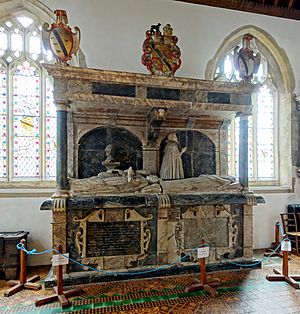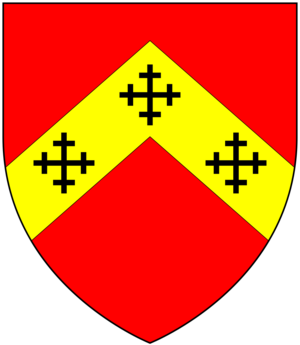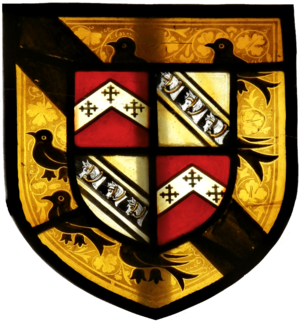Thomas Luttrell (died 1571) facts for kids
Thomas Luttrell (who died in 1571) lived at Dunster Castle in Somerset, England. He was an important person in his area, holding the title of "feudal baron" of Dunster. This meant he was a powerful landowner. He also served as a Member of Parliament (MP) for Minehead from 1563 to 1567. An MP is like a representative who helps make laws for the country. Minehead was a "pocket borough," which meant the Luttrell family had a lot of control over who was elected there. Thomas Luttrell was also the Sheriff of Somerset from 1570 to 1571. The Sheriff was a key official who helped keep law and order in the county.
Family Background
Thomas Luttrell was the second son of Sir Andrew Luttrell (1484–1538). Sir Andrew was also a feudal baron of Dunster and served as Sheriff of Somerset and Dorset in 1528. His mother was Margaret Wyndham (who died in 1580). She was the daughter of Sir Thomas Wyndham (who died in 1521).
Thomas became the head of the family after his older brother, Sir John Luttrell (who died in 1551), passed away. Sir John was a soldier and did not have any sons to inherit the family lands.
His Life and Work
Thomas Luttrell sold some of the family's lands in Devon and Somerset. He kept Dunster Castle, which was the main family home. It seems he sold these lands to pay off debts. However, he later gained a lot of new land and wealth from his wife's family. This new wealth helped replace what he had sold.
His Marriage
On August 27, 1560, Thomas Luttrell married Margaret Hadley. Margaret was the only daughter and heir of Christopher Hadley (1517-1540). Her family owned the manor of Withycombe Hadley in Somerset. The old family home of the Hadleys, called Court Place, still stands in the village of Withycombe today.
Thomas and Margaret were related in a few ways. Margaret was the goddaughter of Thomas's mother. This made them "spiritually related" in the eyes of the church, almost like brother and sister. They were also distantly related by blood, as both were descended from Elizabeth Courtenay (who died in 1493).
Because of these family connections, they needed special permission to marry. In 1557, they received a special document from the Pope, Pope Paul V, to allow their marriage. This was a very important step at the time.
After getting the special permission, Thomas Luttrell and Margaret Hadley were officially married. This happened on August 27, 1560, in the church of East Quantockshead. Their first son, George Luttrell, was born the next month. Later, on a monument built for his parents, their son George made sure to state that they were "lawfully married." This was one of the last times such a special permission was needed for a marriage in England before big changes happened between England and the Church in Rome.
His Children
Thomas and Margaret had seven children together: three sons and four daughters.
- George Luttrell (who died in 1629) was their oldest son and inherited Dunster Castle. He also served as a Member of Parliament for Minehead twice, in 1572 and 1584. George was Sheriff of Somerset twice and built the pier in Minehead harbor. He also started a big project to rebuild Dunster Castle.
- John Luttrell (1566–1620) also became an MP.
- Andrew Luttrell was baptized in Dunster in October 1569. He passed away without having children.
- Cecily Luttrell married Richard Rogers.
- Margaret Luttrell.
- Ursula Luttrell.
- Mary Luttrell was baptized in Dunster in October 1567. She married Sir Robert Strode from Parnham in Dorset.
His Monument
An impressive monument for Thomas Luttrell stands in Dunster Church. His son George had it built in 1621. It includes statues of Thomas and his wife. The monument has an inscription that tells us about Thomas Luttrell. It says he died on January 16, 1570, and was the High Sheriff of Somerset at that time. It also mentions that he was "lawfully married" to Margaret Hadley and lists their children.
The monument also shows family crests (heraldry). These crests tell the story of the Luttrell family and their connections to other important families like the Hadleys and the Pophams.
See also
| Parliament of England (to 1707) | ||
|---|---|---|
| New constituency | Member of Parliament for Minehead 1563 – 1567 With: Thomas Fitzwilliams |
Succeeded by John Colles |





